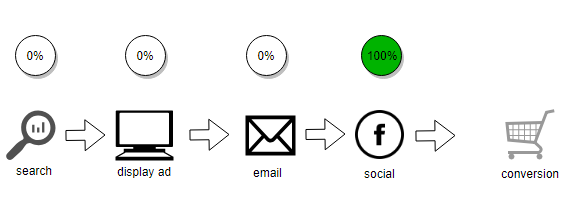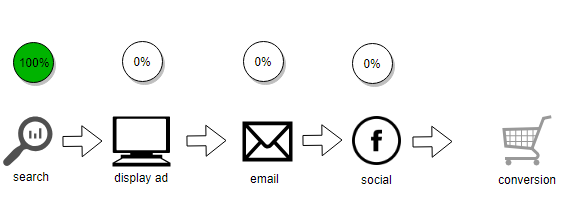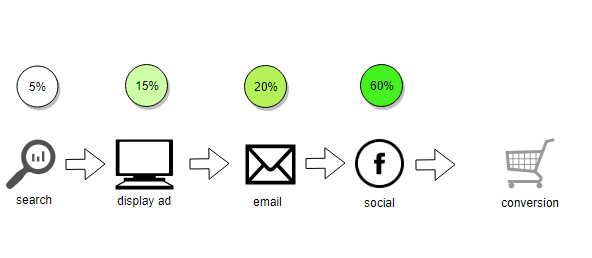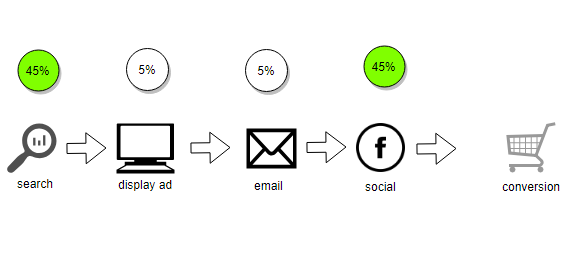Do you have a Marketing Attribution problem?
Attribution Modelling for Marketing is key for accurate attribution. Are you having trouble identifying where your customers are coming from?
Need to know where to best spend your marketing budget to get the best ROI?
Attribution Modelling can help identify your best channels for targeting your audience as well as provide a myriad of benefits to help improve your marketing campaigns.
What is Attribution Modelling?
Attribution Modelling determines how credit for sales and conversions is assigned to touchpoints in conversion paths.
Download XPON’s White Paper: The Advanced Guide to Marketing Attribution for an in-depth look into marketing attribution.
Why is it important?
Advanced marketing attribution programs require marketing departments to aggregate and normalise consumer data from across multiple channels to ensure each interaction is properly weighted.
For example, if a consumer is exposed to a search ad and an email campaign, but only converts after seeing a promotion in the email, marketers can note that this piece of content played a more significant role in driving the sale than the search ad. They can then devote more resources to creating targeted email campaigns.
These types of insights can be drawn, with better accuracy and reliability, from accessing advanced analytics derived from the collection of big data.
Benefits of implementing Attribution
When done correctly, attribution modelling brings forward a suite of benefits to your marketing department. They include:
Increased ROI
Effective attribution enables marketers to reach the right consumer, at the right time, with the right message – leading to increased conversions and higher marketing ROI.
Optimised content
Attribution models that can evaluate the creative elements of a campaign allow marketers to hone messaging and visual elements in addition to a better understanding of how and when to communicate with users.
Improved personalisation
Marketers can use attribution data to understand the messaging and channels preferred by individual customers for more effective targeting throughout the customer journey.
Optimised marketing spend
Attribution modelling gives marketers insights into how the marketing budget is best spent by showing touchpoints that earn the most engagements. This allows marketing teams to adjust the budget and media spend accordingly.
Improvements in product development
Person-level attribution allows marketers to better understand the needs of their consumers. These insights can then be referenced when making updates to the product to target the functionality consumers want.
Misattribution – the problem with Attribution Modelling
There are several common mistakes that lead to misattribution. This can often obscure the success of marketing campaigns. Not having the right information can negatively impact on future any marketing campaign decision making.
For example, multi-touch attribution is often credited with working better for digital mediums, while marketing mix modelling provides stronger insights into offline campaigns. Unifying both of these measurements enhances overall visibility.
To avoid any mistakes caused by misattribution and ensuring you are getting accurate data that properly reflects the user’s customer journey, it is important to consider the following:
Correlation-based bias
Attribution models can be subject to correlation-based biases when analysing the customer journey, causing it to look like one event causes another, when it may not have.
In-market bias
This refers to consumers who may have been in the market to buy the product and would have purchased it whether they had seen the ad or not. However, the ad gets the attribution for converting this user.
Cheap inventory bias
This gives an inaccurate view of how media is performing, making lower-cost media appear to perform better due to the natural conversion rate for the targeted consumers, when the ads may not have played a role.
Each of the biases threatens to have marketers make optimizations in favour of less effective messaging, causing immense damage to ROI.
Digital signal bias
This occurs when attribution models do not factor in the relationship of online activity and offline sales. For marketers who make sales both online and offline, they must make optimisation decisions based on both online and offline data, not only what they can trace digitally.
Brand & behaviour
Attribution models can often overlook the relationship between brand perception and consumer behaviour, or will only look at them at a trend regression level.
Marketers must ensure their attribution models can detect relationships between brand-building initiatives and conversions. Not understanding how their attribution model measures branding impact is a common and detrimental mistake, leading marketers to make decisions based on incomplete recommendations that devalue brand building.
Missing message signal
Creative and messaging are just as important to consumers as the medium on which they see your ad. One common attribution mistake is evaluating creativity in aggregate and determining that one message is ineffective when in reality it would be effective for a smaller, more targeted audience. This emphasises the importance of person-level analytics.
How is Attribution measured?
Marketing attribution can be measured through models that weigh different aspects of the campaign to determine which advertisements were most effective.
There are many models available and many have clear challenges such as combining offline and online data. Choosing the right model is essential to accurately measuring the effectiveness of your campaigns to allocate a budget.
What is an Attribution Model?
Marketing attribution models assign value to marketing campaigns through statistical analysis at the user level. This person-centric approach is why attribution models are more typically applied to digital campaigns than those conducted offline.
Download XPON’s White Paper: The Advanced Guide to Marketing Attribution for an in-depth look into attribution modelling.
Last Interaction/Last Click Attribution model
All standard reports in Google Analytics give one hundred percent of all the credit to the last touchpoint. This is easy to understand, easily implemented, and it might work for some emotional purchases which don’t need any research or are simply “one-touch purchases”.
But, you might look at the purchase data and see some customers bought your product directly. What if those purchasers who bought directly, had visited your website before via email, search ads, organic search, and so on. We should figure out a way to give credit to these channels as well.
Last Non-Direct Click Attribution Model
All the direct channels are ignored and all the credits are assigned to the last channel that the customer clicked before conversion. This model is imprecise and ignores all the channels which might deserve some credit.
Last Click Attribution Model
The Paid Search channel click receives 100% of the credit for the conversion. This model overvalued Ads importance. Your customers might be convinced to buy your product via other campaigns rather than the last Ad they clicked.
First Interaction/First Click Attribution Model
This model is the reverse of the last click and gives all the credit to the first click rather than to the last click. But, if the first channel was that perfect to deserve the credit why do customers bother to enter your website via other channels.
Linear Attribution Model
Each touchpoint in the conversion path shares equal credit for the conversion. However, in most cases this is not true, you should understand which channels give you more value compared to others.
Time Decay Attribution Model
The touchpoint nearest the conversion would receive the highest credit and the touchpoint prior to that will get less credit.
Position-Based Attribution Model
In this model, 40% credit each is assigned to the first and last interactions, and the remaining 20% credit is distributed evenly to the other interactions. This model is one idea that might or might not work for particular types of businesses.
Data-Driven Attribution Model
With Analytics 360, Google will calculate your real Attribution model based on your data. The model is only valid for a week and is dynamic. Google’s Data-Driven Attribution Model uses your Default Channel Grouping to attribute impact on conversion. You can also download the full model and process data as you need it using Excel or GSheets.
Choosing the Right Marketing Attribution Model
Marketers need to think carefully when selecting the right attribution model. Firstly, consider the type of sales cycle currently in use, how long it typically runs, and how much of it is done online or offline. E-commerce sites may not have to factor in offline conversions.
It is also important to consider how much of your marketing efforts are focused on offline methods. Businesses that place a lot of value in these mediums will need to choose an attribution model and platform that is able to correlate and normalise online and offline efforts together for accurate insights.
Ultimately, it is likely to have to implement several attribution models at once for the most complete understanding of the impact of marketing efforts. xp




